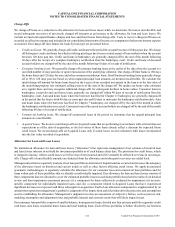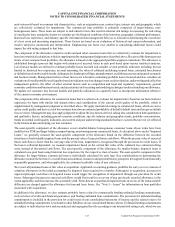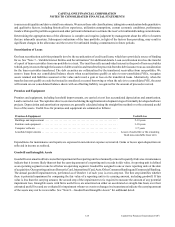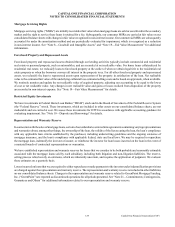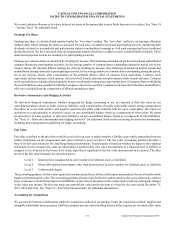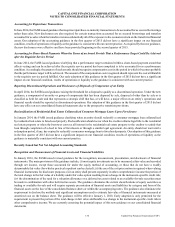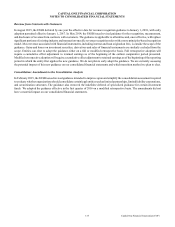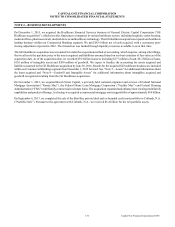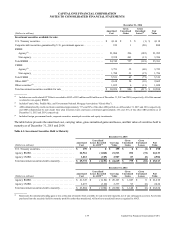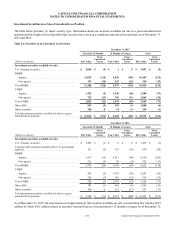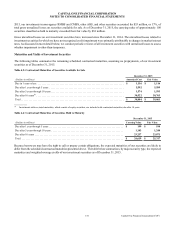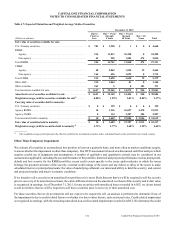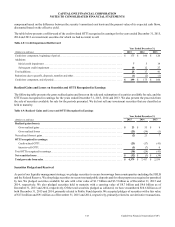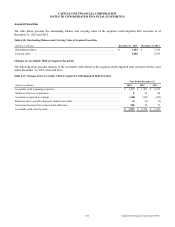Capital One 2015 Annual Report Download - page 153
Download and view the complete annual report
Please find page 153 of the 2015 Capital One annual report below. You can navigate through the pages in the report by either clicking on the pages listed below, or by using the keyword search tool below to find specific information within the annual report.CAPITAL ONE FINANCIAL CORPORATION
NOTES TO CONSOLIDATED FINANCIAL STATEMENTS
134 Capital One Financial Corporation (COF)
Accounting for Repurchase Transactions
In June 2014, the FASB issued guidance that requires repurchase-to-maturity transactions to be accounted for as secured borrowings
rather than sales. New disclosures are also required for certain transactions accounted for as secured borrowings and transfers
accounted for as sales when the transferor retains substantially all of the exposure to the economic return on the transferred financial
assets. Our adoption of the accounting guidance in the first quarter of 2015 did not have a significant impact on our financial
condition, results of operations or liquidity as the guidance is consistent with our current practice. As required by the new guidance,
the new disclosures were effective and have been provided beginning in the second quarter of 2015.
Accounting for Share-Based Payments When the Terms of an Award Provide That a Performance Target Could Be Achieved
after the Requisite Service Period
In June 2014, the FASB issued guidance clarifying that a performance target contained within a share-based payment award that
affects vesting and can be achieved after the requisite service period has been completed is to be accounted for as a performance
condition. Accordingly, the grantor of such awards should recognize compensation cost in the period in which it becomes probable
that the performance target will be achieved. The amount of the compensation cost recognized should represent the cost attributable
to the requisite service period fulfilled. Our early adoption of this guidance in the first quarter of 2015 did not have a significant
impact on our financial condition, results of operations or liquidity as the guidance is consistent with our current practice.
Reporting Discontinued Operations and Disclosures of Disposals of Components of an Entity
In April 2014, the FASB issued guidance raising the threshold for a disposal to qualify as a discontinued operation. Under the new
guidance, a component of an entity or group of components that has been disposed by sale, disposed of other than by sale or is
classified as held for sale and that represents a strategic shift that has, or will have, a major effect on an entity’s operations and
financial results should be reported as discontinued operations. Our adoption of this guidance in the first quarter of 2015 did not
have any effect on our consolidated financial statements due to the prospective transition provisions.
Reclassification of Residential Real Estate Collateralized Consumer Mortgage Loans Upon Foreclosure
In January 2014, the FASB issued guidance clarifying when an entity should reclassify a consumer mortgage loan collateralized
by residential real estate to foreclosed property. Reclassification should occur when the creditor obtains legal title to the residential
real estate property or when the borrower conveys all interest in the residential real estate property to the creditor to satisfy that
loan through completion of a deed in lieu of foreclosure or through a similar legal agreement. An entity should not wait until a
redemption period, if any, has expired to reclassify a consumer mortgage loan to foreclosed property. Our adoption of this guidance
in the first quarter of 2015 did not have a significant impact on our financial condition, results of operations or liquidity as the
guidance is materially consistent with our current practice.
Recently Issued but Not Yet Adopted Accounting Standards
Recognition and Measurement of Financial Assets and Financial Liabilities
In January 2016, the FASB issued revised guidance for the recognition, measurement, presentation, and disclosure of financial
instruments. The main provisions of the guidance include, (i) most equity investments are to be measured at fair value and recorded
through net income, except those accounted for under the equity method of accounting, or those that do not have a readily
determinable fair value (for which a practical expedient can be elected); (ii) the use of the exit price notion is required when valuing
financial instruments for disclosure purposes; (iii) an entity shall present separately in other comprehensive income the portion of
the total change in the fair value of a liability under fair value option resulting from a change in the instrument-specific credit risk;
(iv) the determination of the need for a valuation allowance on a deferred tax asset related to an available-for-sale securities must
be made in combination with other deferred tax assets. The guidance eliminates the current classifications of equity securities as
trading or available-for-sale and will require separate presentation of financial assets and liabilities by category and form of the
financial assets on the face of the consolidated balance sheets or within the accompanying notes. The guidance also eliminates the
requirement to disclose the methods and significant assumptions used to estimate fair value of financial instruments measured at
amortized cost on the balance sheet. The guidance will be effective January 1, 2018. Early adoption is only permitted for the
requirement to present the portion of the total change in fair value attributable to a change in the instrument-specific credit risk in
other comprehensive income. We are currently assessing the potential impact of this new guidance on our consolidated financial
statements.




